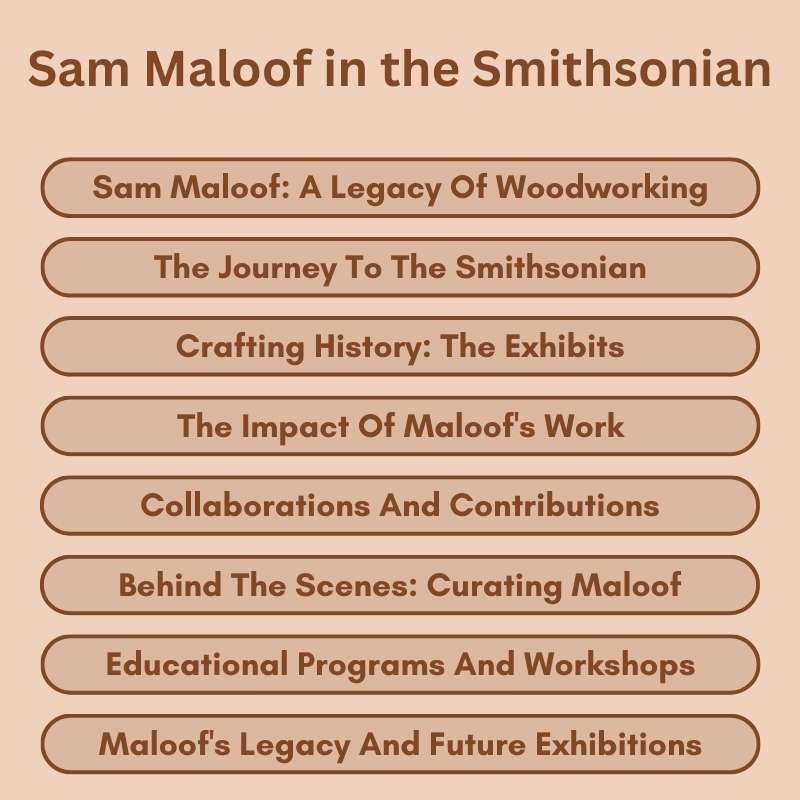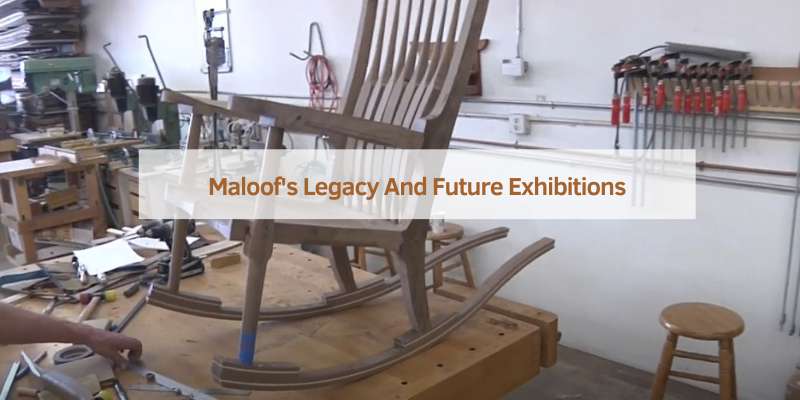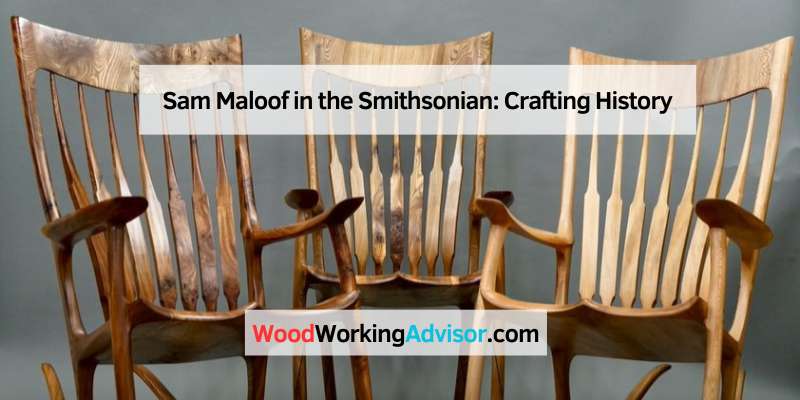Sam Maloof is renowned for his innovative woodworking and furniture design. His work is prominently featured in the Smithsonian, showcasing his craftsmanship and artistic vision.
Sam Maloof, an iconic American woodworker, revolutionized the art of furniture making. His unique style blends functionality with beauty, making each piece a work of art. Maloof’s legacy extends beyond furniture; he embodies the spirit of American craftsmanship. Born in 1916, he faced numerous challenges but persevered to achieve greatness.
His designs, characterized by organic shapes and smooth lines, reflect his deep appreciation for nature. The Smithsonian’s display of his work highlights his influence on contemporary design. Maloof’s creations continue to inspire artisans and furniture makers today, illustrating the enduring nature of his artistic contributions. Discover the story behind his masterpieces and the impact he had on American art.
Sam Maloof: A Legacy Of Woodworking
Sam Maloof was born in 1916. His early life shaped his passion for woodworking. Inspired by nature, he used simple tools. His love for wood began as a child. Maloof learned from many different cultures.
His signature style is unique and recognizable. Curved lines and smooth finishes define his pieces. Each item reflects his dedication to craftsmanship. Maloof often used native California woods like oak and walnut. His techniques combined both functionality and artistry.
Many consider him a pioneer in modern furniture design. His work is both beautiful and practical. Maloof’s chairs and tables are highly sought after. Collectors appreciate his attention to detail. His legacy continues to inspire new generations of woodworkers.

The Journey To The Smithsonian
Sam Maloof’s work is significant in the world of American craft. His first piece, a beautifully crafted chair, was acquired by the Smithsonian. This marked a historic moment for craftsmanship and design.
Representation in such institutions is vital. It shows the importance of diverse artists and their contributions. Maloof’s legacy inspires future generations to appreciate handmade art. His work reflects the beauty of simplicity and functionality.
Through his unique style, Maloof changed how people view furniture. His pieces are not just functional; they are also works of art. The Smithsonian’s collection highlights this artistic value.
Crafting History: The Exhibits
Sam Maloof’s work is a true blend of art and function. His iconic pieces showcase exquisite craftsmanship. Visitors can see his famous rocking chairs and cabinets. Each piece tells a unique story of American design.
The interactive displays invite visitors to engage with Maloof’s techniques. Touch screens explain his methods and materials. Kids can even try their hand at simple woodworking. This makes learning about furniture design fun and exciting.
| Exhibit | Description |
|---|---|
| Rocking Chair | A beautifully crafted piece that reflects comfort and style. |
| Cabinet | Showcases Maloof’s unique joinery and finishing techniques. |
| Woodworking Tools | Displays tools used by Maloof throughout his career. |
The Impact Of Maloof’s Work
Sam Maloof’s work has a huge impact on modern woodworking. His unique style blends traditional and innovative techniques. Many woodworkers admire his attention to detail and craftsmanship. His designs emphasize functional beauty, making them timeless.
Maloof’s influence encourages artisans to explore their creativity. His furniture pieces show how art and utility can coexist. He inspires new generations to appreciate handmade items. This push for quality over quantity keeps craftsmanship alive.
The preservation of craftsmanship is vital in today’s world. Maloof’s legacy motivates others to value skill and tradition. Many workshops today focus on teaching these important techniques. Through Maloof’s example, woodworking continues to thrive.
Collaborations And Contributions
Sam Maloof’s partnerships with other artisans were vital to his success. He worked closely with many talented craftspeople. Together, they created unique pieces that showcased their skills. This teamwork helped elevate American craftsmanship.
Philanthropy played a major role in Maloof’s life. He believed in giving back to the community. Through his scholarships, he supported young artists. These opportunities encouraged creativity and growth in the arts.
| Contribution | Description |
|---|---|
| Partnerships | Collaborated with skilled artisans to create unique art pieces. |
| Philanthropy | Supported local communities and promoted art education. |
| Scholarships | Provided financial aid to aspiring artists for their education. |
Behind The Scenes: Curating Maloof
The selection process for Sam Maloof’s works was very thorough. Curators reviewed many pieces to find the best. They focused on quality, craftsmanship, and historical significance. Each piece tells a unique story about Maloof’s life and work.
Conservation efforts are crucial for preserving Maloof’s art. Experts use special techniques to protect the wood from damage. They check for moisture and temperature to keep the pieces safe. Regular maintenance ensures that the art remains in great condition for future generations.
Educational Programs And Workshops
Educational programs and workshops at the Smithsonian offer hands-on experiences. Participants can learn about the unique techniques of Sam Maloof. Craftsmanship is emphasized in each session.
Workshops teach skills like woodworking, design, and finishing. These activities inspire future artisans. Each program highlights the importance of creativity and hard work.
Visitors can engage with expert instructors. They provide guidance and support throughout the learning process. This helps build confidence and skills.
Join a workshop to explore your artistic side. Create something special while honoring Maloof’s legacy. Experience the joy of making with your own hands.
Maloof’s Legacy And Future Exhibitions
Sam Maloof’s work continues to inspire many. His unique style blends art and function. Artists and designers admire his craftsmanship.
Exhibitions of Maloof’s pieces showcase his innovative designs. Visitors can see his furniture in famous museums. Events focus on his impact on modern woodworking.
Upcoming displays will highlight his creative process. Workshops may teach his techniques to a new generation. These events celebrate his lasting influence.
| Event | Date | Location |
|---|---|---|
| Exhibition Opening | March 15, 2024 | Smithsonian Museum |
| Workshop Series | April 10-12, 2024 | Local Community Center |

Frequently Asked Questions
What Is Sam Maloof Known For?
Sam Maloof is renowned for his exceptional woodworking and furniture design. His work blends functionality with artistic expression. Maloof’s style is characterized by smooth lines and organic shapes, making his pieces highly sought after. He is considered a pioneer in the American studio furniture movement.
Where Can I See Sam Maloof’s Work?
You can see Sam Maloof’s work at the Smithsonian Institution. His pieces are part of the Renwick Gallery’s collection. The gallery showcases American craft and decorative arts, providing visitors a chance to appreciate Maloof’s craftsmanship. His work represents an important chapter in American design history.
Why Is Sam Maloof Significant In American Art?
Sam Maloof holds significant importance in American art for his innovative approach to furniture making. He transformed woodworking into a respected art form. His unique designs and craftsmanship have inspired countless artisans. Maloof’s legacy continues to influence contemporary furniture design.
What Materials Did Sam Maloof Use?
Sam Maloof primarily used hardwoods like walnut, cherry, and maple. These materials enhance the beauty and durability of his furniture. He often incorporated natural finishes, showcasing the wood’s grain and texture. Maloof’s choice of materials contributed to the timeless appeal of his designs.
Conclusion
Sam Maloof’s legacy shines brightly in the Smithsonian. His innovative designs and craftsmanship continue to inspire new generations. The exhibition not only showcases his iconic furniture but also highlights his impact on American art. Exploring Maloof’s work offers a deeper appreciation for the blend of functionality and beauty in design.

